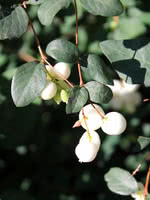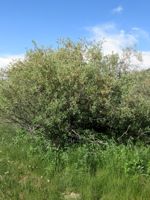Mon-Fri 9am - 5pm Mountain time
Western Snowberry vs Diamond-Leaf Willow
Symphoricarpos occidentalis
Salix planifolia
NOT AVAILABLE THIS SEASON - MIGHT RETURN
CUSTOM GROW
Like the Common Snowberry, the Western Snowberry is a small shrub with pink flowers useful for feeding livestock and preventing erosion. Unlike the common species, however, the Western Snowberry is much more suited to wet conditions, capable of persevering through poor soil drainage and occasional flooding.
After the Snowberry's flowers have bloomed, it produces berries which often last on the plant through winter. These berries are toxic to humans, but livestock and local wildlife love them! Those hoping to attract wildlife to their property can plant Snowberry and expect to see animals foraging on it much later in the year than other plants.
Diamond-Leaf Willow is a native deciduous shrub known for its glossy diamond-shaped leaves, which give the shrub its name. Its catkins emerge in spring, providing an important early source of pollen for pollinators. The shrub’s dense growth also offers valuable cover and browse for wildlife, including moose and deer.
This shrub is well-suited to cool, moist habitats such as wetlands, streambanks, and forest openings. It spreads by rhizomes, helping to stabilize soils and form dense thickets. Diamond-Leaf Willow is valuable for reclamation, wetland enhancement, shelterbelt plantings, and a wide range of conservation and habitat restoration projects.
Western Snowberry Quick Facts
Diamond-Leaf Willow Quick Facts
Toxicity: berries are toxic to humans

